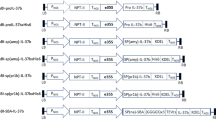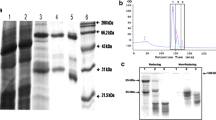Abstract
The KAP-2 protein that binds to the H-box (CCTACC) element in the bean CHS15 chalcone synthase promoter was purified, and internal peptide sequence used to design primers leading to the cloning of KAP-2 from bean (Phaseolus vulgaris) and barrel medic (Medicago truncatula). KAP-2 shares sequence similarity to the large subunit of mammalian Ku autoantigen, a protein proposed to be involved in control of DNA recombination and transcription. KAP-2 sequences were present in genomic DNA from a range of legumes, and a related protein is found in Arabidopsis thaliana. Recombinant KAP-2 expressed in insect cells showed the same binding specificity for the CHS15 H-box as the protein purified from bean cell extracts. In vitro transcription assays confirmed that KAP-2 stimulates transcription from a promoter harboring the H-box cis element.
Similar content being viewed by others
References
Arioli, T., Howles, P.A., Weinman, J.J. and Rolfe, B.G. 1994. In Trifolium subterraneum, chalcone synthase is encoded by a multigene family. Gene 138: 79–86.
Armstrong, G.A., Weisshaar, B. and Hahlbrock, K. 1992. Homodimeric and heterodimeric leucine zipper proteins and nuclear factors from parsley recognize diverse promoter elements with ACGT cores. Plant Cell 4: 525–537.
Cao, Q.P., Pitt, S., Leszyk, J. and Baril, E.F. 1994. DNA-dependent ATPase from HeLa cells is related to human Ku autoantigen. Biochemistry 33: 8548–8557.
Choudary, A.D., Lamb, C.J. and Dixon, R.A. 1990. Stress responses in alfalfa (Medicago sativa L.). VI. Differential responsiveness of chalcone synthase induction to fungal elicitor or glutathione in electroporated protoplasts. Plant Physiol. 94: 1802–1807.
Chu, G. 1997. Double strand break repair. J. Biol. Chem. 272: 24097–24100.
Dakora, F.D. 1995 Plant flavonoids: biological molecules for useful exploitation. Aust. J. Plant Physiol. 22: 87–99.
Dakora, F. and Phillips, D. 1996. Diverse functions of isoflavonoids in legumes transcend anti-microbial definitions of phytoalexins. Physiol. Mol. Plant Path. 49: 1–20.
Dewick, P.M. 1988. Isoflavonoids. In: J.B. Harbone (Ed) The Flavonoids: Advances in Research Since 1980, Chapman and Hall, London, pp. 125–209.
Dixon, R.A., Harrison, M.J. and Lamb, C.J. 1994. Early events in the activation of plant defense responses. Annu. Rev. Phytopath. 32: 479–501.
Dröge-Laser, W., Kaiser, A., Lindsay, W.P., Halkier, B., Loake, G.A., Doerner, P.W., Dixon, R.A. and Lamb, C.J. 1997. Rapid stimulation of a soybean protein-serine kinase that phosphorylates a novel bZIP transcription factor, G/HBF-1, in the induction of early transcription-dependent defenses. EMBO J. 16: 726–738.
Dron, M., Clouse, S.D., Dixon, R.A., Lawton, M.A. and Lamb, C.J. 1988. Glutathione and fungal elicitor regulation of a plant defense gene promoter in electroporated protoplasts. Proc. Natl. Acad. Sci. USA 85: 6738–6742.
Dvir, A., Peterson, S.P., Knuth, M.W., Lu, H. and Dynan, W.S. 1993. Ku auotoantigen is the regulatory component of a template-associated protein kinase that phosphorylates RNA polymerase II. Proc. Natl. Acad. Sci. USA 89: 11920–11924.
Faktor, O., Kooter, J., Dixon, R.A. and Lamb, C.J. 1996. Functional dissection of a bean chalcone synthase gene promoter in transgenic tobacco plants reveals sequence motifs essential for floral expression. Plant Mol. Biol. 32: 845–859.
Faktor, O., Kooter, J.M., Loake, G.J., Dixon, R.A. and Lamb, C.J. 1997a. Differential utilization of regulatory cis-elements for stress-induced and tissue-specific activity of a French bean chalcone synthase promoter. Plant Sci. 124: 175–182.
Faktor, O., Loake, G., Dixon, R.A. and Lamb, C.J. 1997b. The G-box and H-box in a 39 bp region of a French bean chalcone synthase promoter constitute a tissue-specific regulatory element. Plant J. 11: 1105–1113.
Falzon, M. and Kuff, E.L. 1992. The nucleotide sequence of a mouse cDNA encoding the 80kDa subunit of the Ku (p70/p80) autoantigen. Nucl. Acids Res. 20: 3784.
Falzon, M., Fewell, J.W. and Kuff, E.L. 1993. EBP-80, a transcription factor closely resembling the human autoantigen Ku, recognizes single-to double-strand transitions in DNA. J. Biol. Chem. 268: 10546–10552.
Feinbaum, R.L. and Ausubel, F.M. 1992. Transcriptional regulation of the Arabidopsis thaliana chalcone synthase gene. Mol. Cell. Biol. 8: 1985–1992.
Feldbrugge, M., Sprenger, M., Hahlbrock, K. and Weisshaar, B. 1997. PcMYB1, a novel plant protein containing a DNA-binding domain with one MYB repeat, interacts in vivo with a light-regulatory promoter unit. Plant J. 11: 1079–1093.
Franza, B.R. Jr., Rauscher, F.J. III, Josephs, S.F. and Curran, T. 1988. The Fos complex and Fos-related antigens recognize sequence elements that contain AP-1 binding sites. Science 239: 1150–1153.
Genersch, E., Eckerskorn, C., Lottspeich, F., Herzog, C., Kuhn, K. and Poschl, E. 1995. Purification of the sequence-specific transcription factor CTCBF, involved in the control of the human collagen IV genes: subunits with homology to the Ku antigen. EMBO J. 14: 791–800.
Giffin, W., Torrance, H., Rodda, D.J., Prefontaine, G.G., Pope, L. and Hache, R.J.G. 1996. Sequence-specific DNA binding by Ku autoantigen and its effects on transcription. Nature 380: 265–268.
Gottleib, T.M. and Jackson, S.P. 1993. The DNA-dependent protein kinase: requirement for DNA ends and association with the Ku antigen. Cell 72: 131–142.
Hahlbrock, K. and Scheel, D. 1989. Physiology and molecular biology of phenylpropanoid metabolism. Annu. Rev. Plant Physiol. Plant Mol. Biol. 40: 347–364.
Harrison, M.J., Lawton, M.A., Lamb, C.J. and Dixon, R.A. 1991. Characterization of a nuclear protein that binds to three elements within the silencer region of a bean chalcone synthase gene promoter. Proc. Natl. Acad. Sci. USA 88: 2515–2519.
He, X.-Z., Reddy, J.T. and Dixon, R.A. 1998. Stress responses in alfalfa (Medicago sativa L.) XXII. cDNA cloning and characterization of an elicitor-inducible isoflavone 7–O-methyltransferase. Plant Mol. Biol. 36: 43–54.
Higgins, T.J., Zwar, J.A. and Jacobsen, J.V. 1976. Gibberellic acid enhances the level of translatable mRNA for α-amylase in barley aleurone layers. Nature 260: 166–168.
Hiom, K. 1999. DNA repair: RAD52: the means to an end. Curr. Biol. 9: 446–448.
Joshi, C.P. 1987. An inspection of the domain between putative TATA box and translation start site in 79 plant genes. Nucl. Acids Res. 15: 6643–6653.
Junghans, H., Dalkin, K. and Dixon, R.A. 1993. Stress responses in alfalfa (Medicago sativa L.). XV. Characterization and expression patterns of members of a subset of the chalcone synthase multigene family. Plant Mol. Biol. 22: 239–253.
Laemmli, U.K. 1990. Cleavage of structural proteins during the assembly of the head of bacteriophage T4. Nature 277: 680–685.
Landschulz, W.H., Johnson, P.F. and McKnight, S.L. 1988. The leucine zipper: a hypothetical structure common to a new class of DNA binding proteins. Science 240: 1759–1764.
Lawton, M.A. and Lamb, C.J. 1987. Transcriptional activation of plant defense genes by fungal elicitor, wounding and infection. Mol. Cell Biol. 7: 335–341.
Lawton, M.A., Clouse, S.D. and Lamb, C.J. 1990. Glutathioneelicited changes in chromatin structure within the promoter of the defense gene chalcone synthase. Plant Cell Rep. 8: 561–564.
Lawton, M.A., Dixon, R.A., Hahlbrock, K. and Lamb, C.J. 1983. Elicitor induction of mRNA activity: rapid effects of elicitor on phenylalanine ammonia-lyase and chalcone synthase mRNA activities in bean cells. Eur. J. Biochem. 130: 131–139.
Lois, R., Dietrich, A., Hahlbrock, K. and Schulz, W. 1989. A phenylalanine ammonia-lyase gene from parsley: structure, regulation and identification of elicitor and light responsive cis-acting elements. EMBO J. 8: 1641–1648.
Maki, Y., Bos, T.J., Davis, C., Starbuck, M. and Vogt, P.K. 1987. Avian sarcoma virus 17 carries the jun oncogene. Proc. Natl. Acad. Sci. USA 84: 2848–2852.
Martin, S.G., Laroche, T., Suka, N., Grunstein, M. and Gasser, S.M. 1999. Relocalization of telomeric Ku and SIR proteins in response to DNA strand breaks in yeast. Cell 97: 621–633.
Mimori, T., Akizuki, M., Yamagata, H., Inada, S., Yoshida, S. and Homma, M. 1981. Characterization of a high molecular weight acidic nuclear protein recognized by autoantibodies from patients with polymyositis-scleroderma overlap. J. Clin. Invest. 68: 611–620.
Minori, T. and Hardin, J.A. 1986. Mechanism of interaction between Ku protein and DNA. J. Biol. Chem. 261: 10375–10379.
Paillard, S. and Strauss, F. 1991. Analysis of the mechanism of interaction of simian Ku protein with DNA. Nucl. Acids Res. 19: 5619–5624.
Raikhel, N. 1992. Nuclear targeting in plants. Plant Physiol. 100: 1627–1632.
Ryder, T.B., Hedrick, S.A., Bell, J.N., Liang, X., Clouse, S.D. and Lamb, C.J. 1987. Organization and differential activation of a gene family encoding the plant defense enzyme chalcone synthase in Phaseolus vulgaris. Mol. Gen. Genet. 210: 219–233.
Sambrook, J., Fritsch, E.F. and Maniatis, T. 1989. Molecular Cloning: A Laboratory Manual, 2nd ed. Cold Spring Harbor Laboratory Press, Plainview, NY.
Sartorius, C.A., Takimoto, G.S., Richer, J.K., Tung, L. and Horwitz, K.B. 2000. Association of the Ku autoantigen/DNA-dependent protein kinase holoenzyme and poly(ADP-ribose) polymerase with the DNA binding domain of progesterone receptors. J. Mol. Endocrinol. 24: 165–182.
Speicher, D.W. 1994. Methods and strategies for the sequence analysis of proteins on PVDF membranes. Methods 6: 262–273.
Stanton, L.W., Schwab, M. and Bishop, J.M. 1986. Nucleotide sequence of the human N-myc gene. Proc. Natl. Acad. Sci. USA 83: 1772–1776.
Tacciol, G.E., Gottlieb, T.M., Blunt, T., Priestly, A., Demengeot, J., Mizuta, R., Lehmann, A.R., Alt, F.W., Jackson, S.P. and Jeggo, P.A. 1994. Ku80: product of the XRCC5 gene and its role in DNA repair and V(D)J recombination. Science 265: 1442–1445.
Tamagnone, L., Merida, A., Parr, A., Mackay, S., Culianez-Macia, F.A., Roberts, K. and Martin, C. 1998. The AmMYB308 and AmMYB330 transcription factors from antirrhinum regulate phenylpropanoid and lignin biosynthesis in transgenic tobacco. Plant Cell 10: 135–154.
Tuteja, N., Tuteja, R., Ochem, A., Taneja, P., Huang, N.W., Simoncsits, A., Sisic, S., Rahman, K., Marusic, L., Chen, J., Zhang, J., Wang, S., Pongor, S. and Falaschi, A. 1994. Human DNA helicase II: a novel DNA unwinding enzyme identified as the Ku autoantigen. EMBO J. 13: 4991–5001.
Wingate, V.P.M., Lawton, M.A. and Lamb, C.J. 1988 Glutathione causes a massive and selective induction of plant defense genes. Plant Physiol. 87: 206–210.
Yaneva, M., Wen, J., Ayala, A. and Cook, R. 1989. cDNAderived amino acid sequence of the 86–kDa subunit of the Ku autoantigen. J. Biol. Chem. 264: 13407–13411.
Yu, L., Lamb, C.J. and Dixon, R.A. 1993. Purification and biochemical characterization of proteins which bind the H-box cis-elements implicated in transcriptional activation of plant defense genes. Plant J. 3: 805–816.
Zhu, Q., Chappell, J., Hedrick, S.A. and Lamb, C.J. 1995a. Accurate in vitro transcription from circularized plasmid templates by plant whole cell extracts. Plant J. 7: 1021–1030.
Zhu, Q., Dabi, T., Beeche, A., Yamamoto, R., Lawton, M.A. and Lamb, C. 1995b. Cloning and properties of a rice gene encoding phenylalanine ammonia-lyase. Plant Mol. Biol. 29: 535–550.
Zhu, Q., Dabi, T. and Lamb, C. 1995c. TATA box and initiator functions in the accurate transcription of a plant minimal promoter in vitro. Plant Cell 7: 1681–1689.
Author information
Authors and Affiliations
Rights and permissions
About this article
Cite this article
Lindsay, W.P., McAlister, F.M., Zhu, Q. et al. KAP-2, a protein that binds to the H-box in a bean chalcone synthase promoter, is a novel plant transcription factor with sequence identity to the large subunit of human Ku autoantigen. Plant Mol Biol 49, 503–514 (2002). https://doi.org/10.1023/A:1015505316379
Issue Date:
DOI: https://doi.org/10.1023/A:1015505316379




